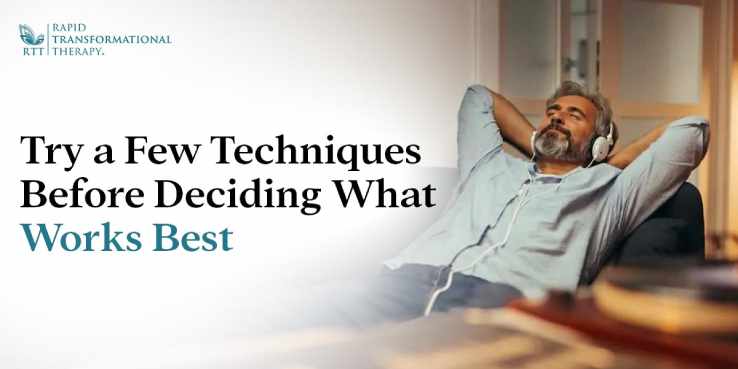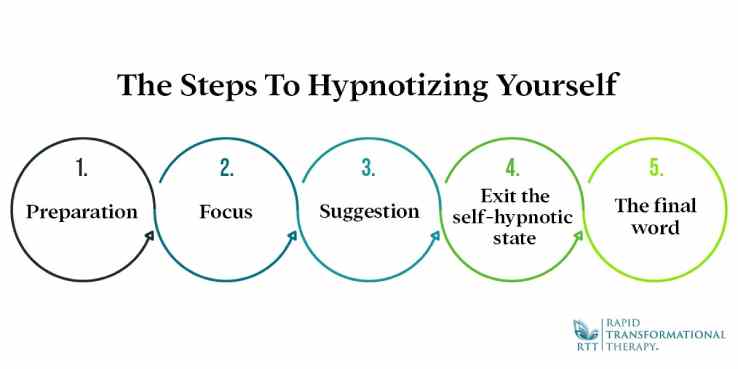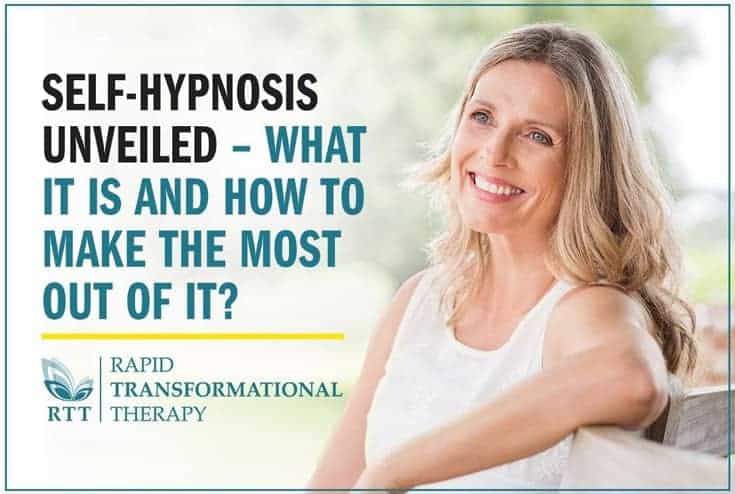You might have been thinking about learning self-hypnosis (or autohypnosis) and wondering if you can do hypnosis on yourself for a while now – and for good reason! It has proven very useful for helping with numerous ailments in clinical practice and scientific research.
Whether you have timidly googled self-hypnosis, or have already dived into learning the technique, this article will provide you with comprehensive practical knowledge and tips to benefit from learning and practicing autohypnosis.
In this article you will learn:
- What self-hypnosis is and what it is not
- What autohypnosis can help you with
- How hypnosis works
- Most effective self-hypnosis techniques
- How to hypnotize yourself
Let’s begin…
What Self-Hypnosis Is And What It Is Not
We could describe self-hypnosis as a self-induced state of deep relaxation and openness of your consciousness. As opposed to hypnotherapy, you do not need anyone else’s guidance.
When you self-hypnotize yourself, you lead your own mind and body into a profoundly relaxed state. The door to your subconsciousness opens. You become more susceptible to suggestions.
By bypassing your conscious mind’s rigid control, you allow for ideas to become embedded into your subconscious mind. These suggestions help with a variety physical or psychological issues.
Often, we are actually experiencing autohypnosis unknowingly. Hard to believe? Here are two examples of how you have already been in a hypnosis state.
What is autohypnosis?
Can you recall a time when you got utterly mesmerized by the ocean or a crackling fire? How you got lost in time and entered a state entirely free of racing thoughts? At that moment, you were in a hypnotic state.
Another example of (unwanted) spontaneous self-hypnosis is when our minds use it to generate stress, anxiety, and fear in our lives.
At some point, we all acquired limiting beliefs about ourselves, others, or the way things work in the world. These beliefs became negative suggestions that operate within our subconscious mind. They can disempower us and induce all kinds of emotional disturbances.
When intentionally practicing autohypnosis, you are able to take control of this powerful process and use it to your benefit.
Self-hypnosis as a development tool
Self-hypnosis allows you to lead yourself into the same trance-like state. Just as if you were absorbed by looking at the waves or a fireplace. Then you can use carefully crafted suggestions to teach your subconscious mind how to cope with stress, adverse emotions, and liberate yourself from limiting beliefs.
Therefore, self-hypnosis is a powerful self-development tool.
What Self-Hypnosis Can Help You With

Hypnosis and self-hypnosis is used in clinical psychology practice to relieve both physical and psychological problems. It has been used for decades.
It is also taught to children and youth as a means of reducing migraines, pain, habit cough, or different hardships of dealing with cancer.
Self-hypnosis can help you:
Lose weight—Studies have shown that self-hypnosis aids weight loss, even among morbidly obese individuals. Also, if you have type 2 diabetes, practicing autohypnosis is found to be more helpful in reducing weight than talking to a certified diabetes educator.
Quit smoking—Self-hypnosis is effective in assisting people trying to stop smoking, both as a supporting complementary therapy and as a standalone treatment.
Fight addictions—Studies have shown great benefits of self-hypnosis in dealing with drug and alcohol addiction, gambling, internet addiction, and other forms of addictive behavior.
Reduce anxiety—Autohypnosis is able to help decrease anxiety – be it in general or anxiety related to education, relationships, or work. It also helps with certain manifestations of anxiety, such as irritable bowel syndrome.
Cope with stress—You can practice self-hypnosis to manage both acute tension and emotional trauma. It is equally effective in helping you cope with daily stressors better. Studies have demonstrated the power of the technique in reducing stress even among cancer patients.
Defeat fears and phobias—The technique is a successful a tool to set yourself free from different fears and phobias such as flying (airline) phobia, agoraphobia, fear of dentists, or needle phobia.
Reduce pain—Knowing how to practice self-hypnosis is very useful in relieving acute pain, such as pain during childbirth, or reduce chronic pain that otherwise can make your life miserable.
Sleep better—Learning how to enter the profoundly relaxed state of self-hypnosis, combined with the power of suggestions, can help you tackle sleep disturbances and get a good night’s sleep.
Aid your self-growth—The process of self-hypnosis allows for our limiting beliefs to dissolve and be replaced with new, empowering ones. This is why this technique is a vessel towards wellbeing and personal growth.
Does Self-Hypnosis Really Work?

Hypnosis (including the one you perform on yourself) is not magic, it’s science. It is simply helping your mind and your body “do their thing.” What do we mean by this?
Human beings became alienated from our nature throughout the evolution of humankind. Technological advancements happened a lot quicker than our biological (and psychological, to an extent) development.
In the modern world, our minds are cluttered and overwhelmed. We cannot seem to cope well with the constant downpour of stimuli.
Hypnosis harnesses your brain’s ability to regulate the body. Your mind has the innate power to control the automatic thoughts that bounce around your head throughout the day.
These thoughts are often intrusive, repetitive, almost obsessive. We do not get a chance to resume control over them unless we make an effort to learn an effective technique such as self-hypnosis.
What is the mechanism in the background of this process?
In an autohypnosis session, muscle tension eases. This effect alone makes it difficult for your mind to remain tense. However, brain scans on people under hypnosis revealed that there is more to hypnosis than that.
Three types of changes happening in the brain under hypnosis were detected during the Stanford University study leading to interesting conclusions.
- Firstly, you become so absorbed that you stop worrying about anything else.
- Secondly, under hypnosis the brain-body connection increases, which means that your brain can better understand and manage what is happening in the body.
- Finally, under hypnosis, you are more suggestible as you disconnect from overthinking or analyzing the suggestions and your mind just accepts them. This means that they can have a much greater impact.

Self-hypnosis and psychotherapy
Hypnosis has been used in psychotherapy ever since the earliest days of psychology as a science. Throughout the years, hypnotherapy has evolved and is now substantiated by scientific evidence of its effectiveness.
So, can you hypnotize yourself?
Yes, it is possible to hypnotize yourself and get some great results.
Self-hypnosis can be used as a standalone treatment in some instances. It is also an aid to psychotherapy in cases of more serious psychological disturbances.
Hypnosis can assist a client who is in psychotherapy to explore painful thoughts, emotions, or memories that they had hidden from their conscious awareness.
Additionally, it can help to see and think about things differently. That is, to reassess automatic beliefs and habit patterns that hinder success and wellbeing.
Can self-hypnosis be dangerous?
Autohypnosis is a legitimate tool used in clinical and non-clinical psychology. However, as with any other technique, we advise due caution.
A lack of expertise is likely to be the most common reason for experiencing undesirable consequences when under self-hypnosis.
When you open the gates of your subconscious mind, you are allowing for potentially traumatic and painful memories and thoughts to surface. Be prepared to tackle them when they appear.
You could also unwantedly lead yourself to feel worse than before autohypnosis by phrasing suggestions wrongly. These potential dangers of self-induced hypnosis are the reason why it is best to consult a hypnotherapist first.
A professional will help you design your self-hypnotic sessions to make them safe and beneficial. You can also download audios by professionals, which will guide you through the process.
Self-Hypnosis Techniques

There are several known hypnosis techniques, and it is worth trying a couple before deciding which works best for you.
Self-hypnosis audios
You can begin familiarizing yourself with the technique by listening to audios pre-recorded by a professional hypnotherapist. Pick a recognized authority in hypnotherapy – such as Marisa Peer, who is a world-renowned speaker, therapist, and bestselling author – and download their guided sessions.
It will help you enter the desired state quicker, and without having to wonder if you are on target. Ideally, contact a licensed hypnotherapist that will create a custom-tailored audio recording for your specific needs.
Self-guided relaxation
Although self-hypnosis is not the same as meditation, they do intertwine in certain elements. You can try this technique as a second choice to guided sessions to gain more experience.
Sit or lay comfortably. Focus on your breath, and slowly relax your eyes. If thoughts come to you, let them drift away. When you are ready, start thinking “calm”, “relaxed”, or “peaceful” with every breath out. Continue this practice as you fall deeper and deeper into relaxation and harmony of your mind.
Visualization self-hypnosis
When you decide on the goal of your self-hypnotic practice and the desired suggestions, pick the right scene to visualize. Be it a vacant beach, a quiet forest, your own safe place, or your new CEO office – hypnosis will take your mind and your body there.
When you do visualize the scene of your choosing, do not stop at imagery. Hear the sounds, feel the textures, smells, and tastes. It will make the suggestion that much more effective.
This type of visualization is also used in Rapid Transformational Therapy® (RTT®) to quickly bring the desired changes to clients.
RTT® is an award-winning solution-based treatment accredited by multiple relevant professional bodies and associations. It incorporates the elements of hypnotherapy, NLP, neuroscience, CBT, and psychotherapy, and has a track record to help achieve long-lasting changes in only one to three sessions.
How to Hypnotize Yourself

As you know by now, the technique can be very efficient, and very quick in bringing you benefits.
“So, how can I hypnotize myself instantly?”—you might ask.
The steps are fairly simple, although mastering them does take some practice. Here are four basic stages of self-hypnosis that will give you what you need to start practicing it straight away.
Preparation
Find a peaceful, quiet, and comfortable place. Set aside 15-30 minutes during which you will not be disturbed. Turn off your devices, as well as the doorbell, if possible. It is probably best that you sit instead of lying down so that you do not fall asleep (although, if you do, that is also perfectly fine).
Focus
When you are ready, start focusing on your breathing. This is an essential portion of hypnosis because it allows you to gain control over your thoughts. Relax your body.
Suggestion
Prepare your suggestion before you start the actual process of hypnotizing yourself. This is important because there are rules on how to phrase suggestions correctly.
If you are uncertain, consult a licensed hypnotherapist, such as a trained RTT® therapist who has experience in the field, because phrasing a suggestion wrongly can, in fact, bring more harm than good.
Make suggestions positive and use them in the present tense. Our subconscious mind is quite literal, so they also need to be very specific.
An example of a good suggestion for someone who is about to hold a speech is “I am feeling confident in my role as a public speaker”.
This is much better than saying something like “I am not going to panic” – as this suggestion is negative, planting the idea of panicking. This is like the classic example of NOT thinking about a pink elephant – your mind doesn’t register the ‘not’ and just makes you think of it.
Exit the self-hypnotic state
Exiting the hypnotic state gradually feels much better than an abrupt interruption. Start with making a decision in your mind that you will be slowly exiting the hypnotic state.
Then, count backward from five, while saying to yourself: “I am exiting this state, I am awakening, I am awake, I am fully awake and energized” after each number.
Slowly open your eyes and start noticing the sounds surrounding you. Notice something in your room you have not noticed for some time. You have now exited the hypnotic state.
The final word
Self-hypnosis can be an invaluable tool on your path towards personal development and wellbeing. It can help you address existing disturbances, blockages, limiting beliefs, and setbacks.
If you need some more guidance as you dive into self-hypnosis, be sure visit Marisa Peer’s store to browse all her available audios, read reviews, and listen to samples. Once you’ve found what you’re looking for you can download your first self-hypnosis audio and take the first step towards a powerful and profound transformation that will change your life for good.
If hypnosis is something you practice regularly and enjoy, consider it as a career. Many become RTT® therapists who have never though it before, simply because they have a love of hypnosis, helping people, and want a flexible, and rewarding career where they can be their own boss. Interested? Click the banner below to find out more.




